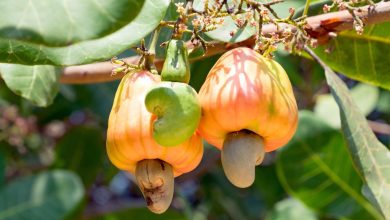Plant Eggplants in [12 Steps]: Guide to Harvest Successfully
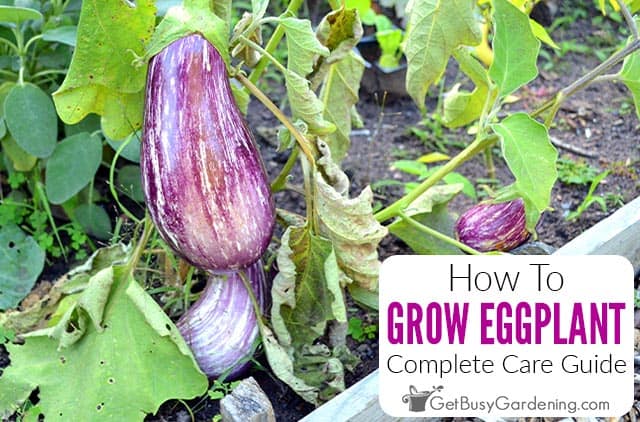
A questionthat comes to us on a recurring basis: How to plant aubergines?
It shouldn’t have to be complicated, however the eggplantsthey require specific conditions to grow strongly.
And this usually causes problems.
Did you know?
We explain each ofthe points you need to know to achieve it on your own. In your own urban, homemade or ecological garden.
So you can sow, harvest and eat your own ECOLOGICAL eggplants.
How to Grow Eggplants Step by Step:
- When? Between March and May.
- Where? Place of maximum sun exposure. Between 6-8 hours daily minimum of sun.
- Harvest time? Between 60 and 90 days from sowing.

- How do we prepare the land? Stirred, aerated, drain well. A pH of 6-7.
- How do we pay? Abundant organic matter and earthworm humus. Manure and organic waste ( composting) are recommended.
- How do we water? Ideal, with drip. It requires a lot of water.
- How often do we water? In summer daily, between 30-40 minutes.
- How do we sow? They require a lot of space. Bury two seeds together. Leave a gap between 50-70cm between the other seeds you plant.
- How do we harvest? Requires pruning of suckers and other stems. Dry cut on the stem of the fruit. Ideal with scissors.
- Good associations? Garlic, celery, onion, cabbage, spinach, lettuce, radishes, nasturtium and carrots.
- Bad associations? Cucumber and zucchini.
- Plagues and diseases? Potato beetle, red spider mite, whitefly, thrips, downy mildew and powdery mildew.
Characteristics of the eggplant
The eggplant is a type of vegetable with edible fruit, possessing a large amount of nutrients that are beneficial to health.
It is recognized mainly for its characteristic ovoid shape as well as for its intense purple color, although in nature there are many varieties, each with different sizes, shapes and colors.
 Although planting aubergines is not too complicated, it is important to keep in mind that it is a very demanding vegetable, since it requires a lot of sun and space to grow.
Although planting aubergines is not too complicated, it is important to keep in mind that it is a very demanding vegetable, since it requires a lot of sun and space to grow.
Furthermore, like all solanaceous plants, it is very voracious, demanding large amounts of water and nutrients.
So now you know, if you are willing to grow it in your garden or garden, you should take time to care for it. We can assure you that with the first shoots you will feel that everything has been worth it.
Did you know…The ancient peoples of the Mediterranean nicknamed it the «crazy apple», as they believed that the daily consumption of aubergines could cause dementia.
Conditions for growing eggplants
To plant eggplants effectively, the following factors must be considered:
Irrigation for eggplant
To plant aubergines, watering must be abundant and regular. The soil must remain moist to the touch at all times.
This is very important since the eggplant needs to be exposed to the sun for a long time.
Tips on watering
 The eggplant is mainly composed of water, so we must ensure that it is always well watered.
The eggplant is mainly composed of water, so we must ensure that it is always well watered.- The ideal for this type of crop is drip irrigation, so we make sure that it does not lack water without flooding the plant.
- Optimum humidity is achieved by watering every 1-2 days.
Remember that the eggplant supports high temperatures well as long as there is adequate humidity, so before sowing, make sure that the soil where you will plant them drains easily.
If your garden is prone to flooding, you need to do everything you can to fix it. You can create slopes so water runs off to the side and install gutters to make it easier to collect water.
Another effective technique is to create mounds of soil and plant on them, so less water will accumulate at the foot of your plants.
At planting time, add a good amount of mulch, compost, peat or manure to fluff up the soil and aerate it. If you also add river sand and mix it well with the soil, the result will be favorable.
In extreme cases, it is best to install a network of drainage pipes.
The climate that the eggplant needs
Aubergines withstand heat better and are sensitive to cold, so their cultivation is abundant in summer. However, thanks to greenhouse production, it is always available on the market.
weather tips
- The aubergine is the fruit vegetable that needs the most heat. For this reason, protected sowing is recommended to avoid frost, especially in colder areas. Another advantage of doing it this way is that your harvest can be brought forward.
 Keep in mind that the aubergine requires between 8 and 10 hours of light for its cultivation, since it is very sensitive to cold.
Keep in mind that the aubergine requires between 8 and 10 hours of light for its cultivation, since it is very sensitive to cold.- You can prepare seedlings or seedlings if you are in an area with a continental climate or sow directly if you are in an area with a temperate climate.
- Full, direct sun will provide enough light and heat to stimulate the growth of your plants.
- During the shortest days of the year, it is necessary to make the most of the hours of light to avoid thinning, malformation of flowers and leaves, or poor fertilization.
The average temperature for good growth is between 23 and 25º C, although it tolerates higher temperatures well, as long as the humidity is adequate, tolerating up to 40-45ºC.
As well as low temperatures, very humid ones can also affect them, causing their flowers to fall. In addition, they can reduce the fertilization process, resulting in fewer fruits.
Avoid growing eggplants in areas with strong currents or winds because they can damage them.
Did you know…Wild species of aubergine, in addition to producing very bitter fruit, grow with thorns on their surface, including the calyx of the fruit.
The Nutrients
The aubergine is very demanding in terms of nutrients, which is why it requires a large fertilization.
From the setting of the first fruits, a little more fertilizer can be applied, since the harvest season is quite long.
Nutrient Tips
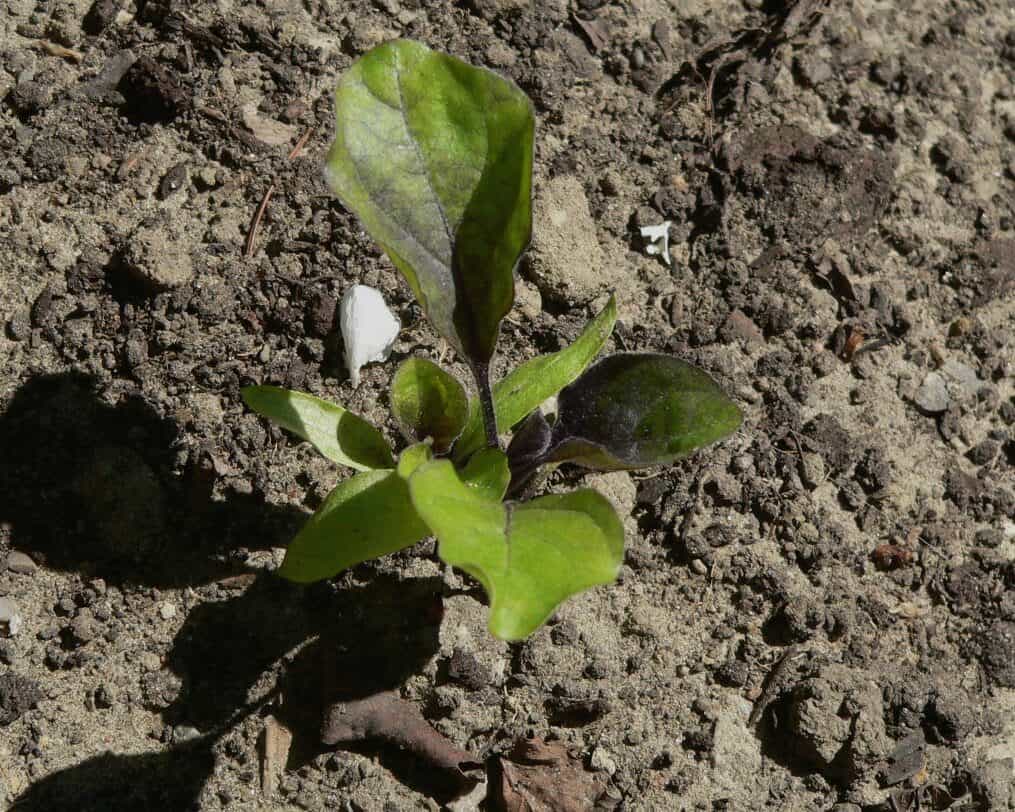 What is known as carbonic fertigation is recommended, which consists of the use of carbonated water for irrigation.
What is known as carbonic fertigation is recommended, which consists of the use of carbonated water for irrigation.- The use of carbonated water offers certain advantages in sowing eggplant, such as soil acidification, which facilitates the solubility and correct absorption of nutrients.
- It also increases the quality and number of fruits and replaces the use of nitric acid.
- It is recommended that you make sure to measure the pH of the soil and adjust the need if necessary. Optimum pH values range between 6 and 7, although in sandy soils it can be grown with pH values between 7 and 8.5.
- Before growing the eggplant, apply homemade organic matter such as compost or earthworm castings to the soil.
the substrate
The aubergine requires loamy and deep soils, although it is not a demanding crop in terms of substrate, since it has a fairly powerful and fast-growing root system, which is why it needs space to develop, above all, its horizontal roots.
Substrate Tips
- The substrate must have good drainage, be well aerated and soft. Mulching should be maintained throughout the growing process, as it helps regulate temperature and humidity.
- The ideal is to mix the soil with a large amount of compost or fertilizer, and keep it always moist.
- Despite its low demands on the substrate, the most suitable soils are loamy and deep ones.
- In clay soils root suffocation problems may occur and in acid soils it presents growth and production problems.
- The eggplant is less resistant than the tomato to the salinity of the soil and irrigation water (however, it is more resistant than the pepper), and is more vulnerable during the early stages of development.

For cultivation in pots, seedlings or containers, a minimum capacity of 30 liters is recommended. Each eggplant plant requires about a foot of space to grow.
Therefore, you may want to plant only one plant per pot.
It is recommended that the container where you place it be ceramic, since it retains heat better. It must have good drainage.
Enameled pots retain moisture better than those without enamel. If you use a pot without enamel you will have to water it more frequently.
Before planting eggplants…
Eggplant seeds
The seed to plant eggplant is extracted from the ripe fruits.
pH
Check the pH of the soil. Optimum pH values are between 6 and 7.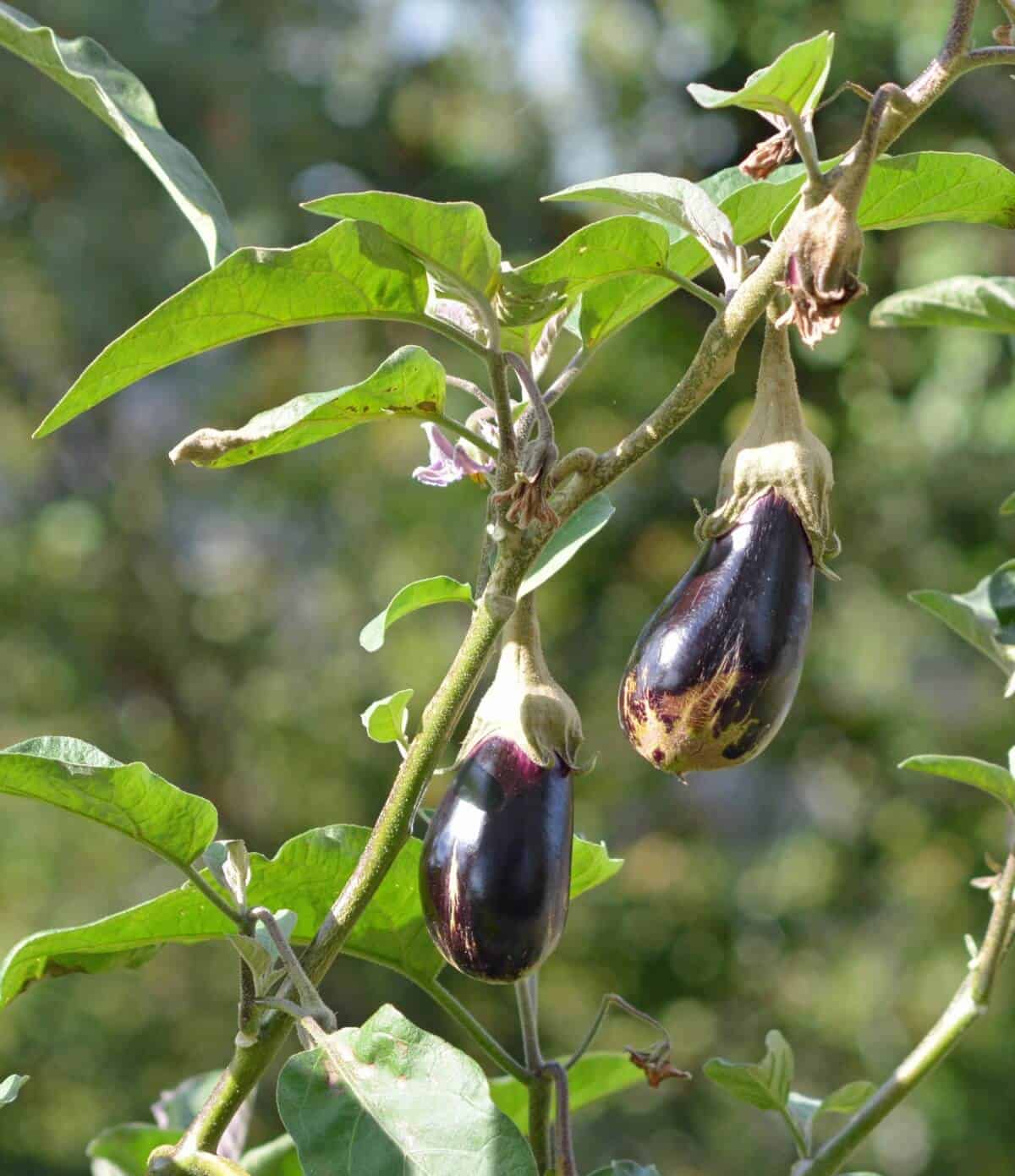
If you need to increase the pH, try using agricultural lime.
If you need to lower the pH, add additional organic matter, such as compost or plant waste. You can also try a fertilizer that contains urea.
Fertilizer to grow aubergines
Before growing the eggplant, apply compost or earthworm humus to the soil.
Where do we sow?
Preferably outdoors. With direct sun, for at least 8 hours.
If you plant in a pot, make sure that it is at least 30 liters in capacity and more than 30 cm in circumference so that the plant has enough space to grow.
To plant your seeds in a pot, you must follow the same steps as for planting them outside.
Did you know…There is a variety known as Black Magic, which contains almost three times the amount of phenolic antioxidants compared to other types of brinjal.
land preparation
The land must have a good filter. Also, it should be loose enough, without being compressed.
If you plant in a pot, a good recommendation is to mix two parts of soil and one part of sand. The soil offers your plant the nutrients it needs, while the sand controls humidity.
How to Plant Eggplants
When? The dates
Between March and May, although a protected sowing can be done from the month of January.
The planting process
- Try to keep them at a temperature of approximately 23 ºC, this will favor the success of germination.
- Dig a half inch hole in the ground. Then put two seeds in each hole. This improves the chances of germination.
- However, consider that planting more than two seeds can deprive the seeds of the nutrition they need to take root.
- Cover the seeds with a thin layer of soil and water them carefully so that the water does not remain puddled.
Did you know…Eggplants are one of the few edible nightshades, as they are rare in nature. Most nightshades produce toxic alkaloids, such as belladonna, mandrake, and henbane.
The first shoots

On average, the seeds take 7-10 days to germinate.
If both seeds have germinated in a hole, keep the stronger one. To do this, do not pull the weak one, as you can damage the leaves. A simple pruning at ground level is sufficient.
Eggplants grow best outdoors, even in pots, as they have more access to sunlight, and can be pollinated.
When the shoots have reached a height of 15 cm. you should remove them from the tray, being very careful not to damage the roots.
the transplant
Transplant only if the weather is warm enough.
With the help of a shovel or hoe, dig holes in the ground to insert the seedling. Make sure that the soil is previously worked, well fertilized and that it has a lot of depth. Remember that eggplants have a wide and powerful root system.
Place the plants with a separation between them of between 50 and 70 cm. If the separation is less, you run the risk that they do not receive enough light and the air does not circulate properly.
The Aubergine Tutoring
- The taller the eggplant plant, the better. Therefore, they require a support system. Without any support, eggplants will not grow large enough and as a consequence will produce very little fruit.
- In addition, the trellis is essential to prevent the stems from breaking due to the weight of the fruits and also improves ventilation and light conditions.
The pruning of the eggplant
- As the plant grows, we will have to prune the branches below the first branch. This is done to limit the number of stems with which the plant will develop.
- Pruning is necessary to improve fruit quality. It is also necessary to keep the plant ventilated and that the sun enters it well.
- We also advise you to rinse the fruits that are poorly formed or damaged by pests or diseases.
- Finally, it is advisable to remove the suckers and leaves that develop below the withers, otherwise you will have smaller aubergines.
When to harvest eggplants?
It is a medium-long cycle crop, so the harvest begins between 60 and 90 days after the transplant and is uninterrupted until the nutrients are exhausted or the first cold weather arrives.
 The fruit is harvested immature, before the seeds form and lose part of its properties.
The fruit is harvested immature, before the seeds form and lose part of its properties.
Therefore, they should be cut at the moment the plant flowers and before they are fully grown, since the fruits with seeds bitter the palate, so it is not necessary that the fruit has reached its physiological maturity.
Harvesting is done with scissors, cutting above the fruit to leave a stalk of about 2 centimeters.
To know the right moment, it is recommended to touch them. The top should be a bit soft.
Gently press down on it with your thumb, if the shell sinks but returns to its original shape, it is ready to be harvested. On the contrary, if the meat is tough and does not sink, the eggplant is not ripe and is too young.
Likewise, the fruit should have a very attractive shiny appearance.
The average time between two consecutive harvests is 5 to 10 days, depending on environmental conditions.
the post harvest
It is convenient to consume them immediately, although they can be kept for a few days in the fridge. The storage period for aubergines is generally less than 14 days, as they deteriorate rapidly.
Decays are also likely to increase when stored for more than two weeks.
Good associations?
Pairs well with garlic, celery, onions, cabbage, spinach, lettuce, radishes, and carrots.
Bad associations?
On the other hand, it is incompatible with cucumber and zucchini.
Common pests and diseases
Being a solanaceous plant, it is greatly affected by fungi such as mildew or powdery mildew. Other pests that can affect it are aphids, thrips, whiteflies, potato beetles, caterpillars and red spiders.
potato beetle
It appears in the form of a caterpillar and devours the leaves. To combat it, a manual collection of adults and eggs is recommended, and the application of Bacillus. They can also be planted with beans.
Red spider
It appears especially in the periods that the plant is in the greenhouse. To combat it, it is recommended to water the aubergine at night and by sprinkling to maintain humidity and use natural insecticides.
 White fly
White fly
To prevent it, the underside of the leaves can be sprayed with 1% potassium soap with rain or distilled water.
thrips
Thrips are flying insects that leave white spots with black dots on leaves. To combat it, a combined application of neem extract and potassium soap is recommended.
powdery mildew
To prevent powdery mildew, it is recommended to install a drip irrigation system and apply horsetail. If the plant is infected, the leaves should be cut.
ribbed cochineal
- The ribbed mealybug bases its diet on the consumption of sap that it sucks from different areas of the plants.
- However, this is damage that could be considered primary, since subsequent consequences that cause concern are also generated.
- The first of them is that they discard a kind of molasses that they leave throughout the plant.
- This molasses is attractive to other insects, such as ants, who find it a pleasant food source.
Main benefits of eggplants
Aunque su valor energético y nutritivo es relativamente menor a otras frutas y hortalizas, la berenjena provee una combinación impresionante de muchos minerales y vitaminas.
También aportan una excelente cantidad de fibra, ácido fólico, potasio y manganeso, entre otros.
Entre la gran variedad de beneficios que la berenjena aporta a la salud, podemos encontrar los siguientes:
- Son una excelente fuente de fibra, por lo que es una opción ideal para las personas con sobrepeso o problemas de estreñimiento. Su grasa es más abundante en la piel y en las semillas.
- Posee un alto contenido en flavonoides; estos están asociados a un menor riesgo de mortalidad por enfermedades cardiovasculares.
- También poseen ácido clorogénico, un compuesto fenólico antioxidante que evita la degeneración celular.
- Su mineral más abundante es el potasio. El potasio es esencial para la transmisión de los impulsos nerviosos y para la actividad muscular.
- Además, el potasio ayuda a eliminar toxinas gracias al efecto diurético que ejerce sobre el organismo. Por lo mismo, es un remedio eficaz para la retención de líquidos, así como para regular la tensión arterial.
- El extracto de berenjena, gracias a su alta concentración de delfinidina, puede inhibir l

![Photo of Carmona Bonsai Care: [Earth, Humidity and Pruning]](https://www.complete-gardening.com/wp-content/uploads/2022/08/carmona-bonsai-care-earth-humidity-and-pruning-390x220.jpg)
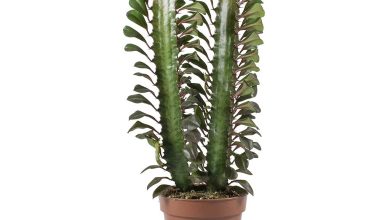
![Photo of Transplant Basil: [Conditions, Time, Tools and Land Preparation]](https://www.complete-gardening.com/wp-content/uploads/2022/08/transplant-basil-conditions-time-tools-and-land-preparation-390x220.png)
